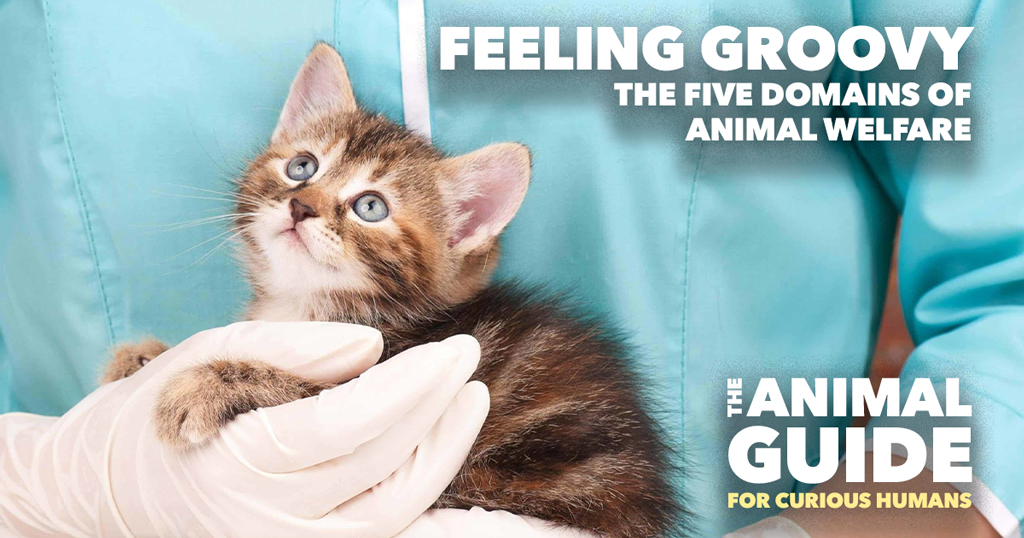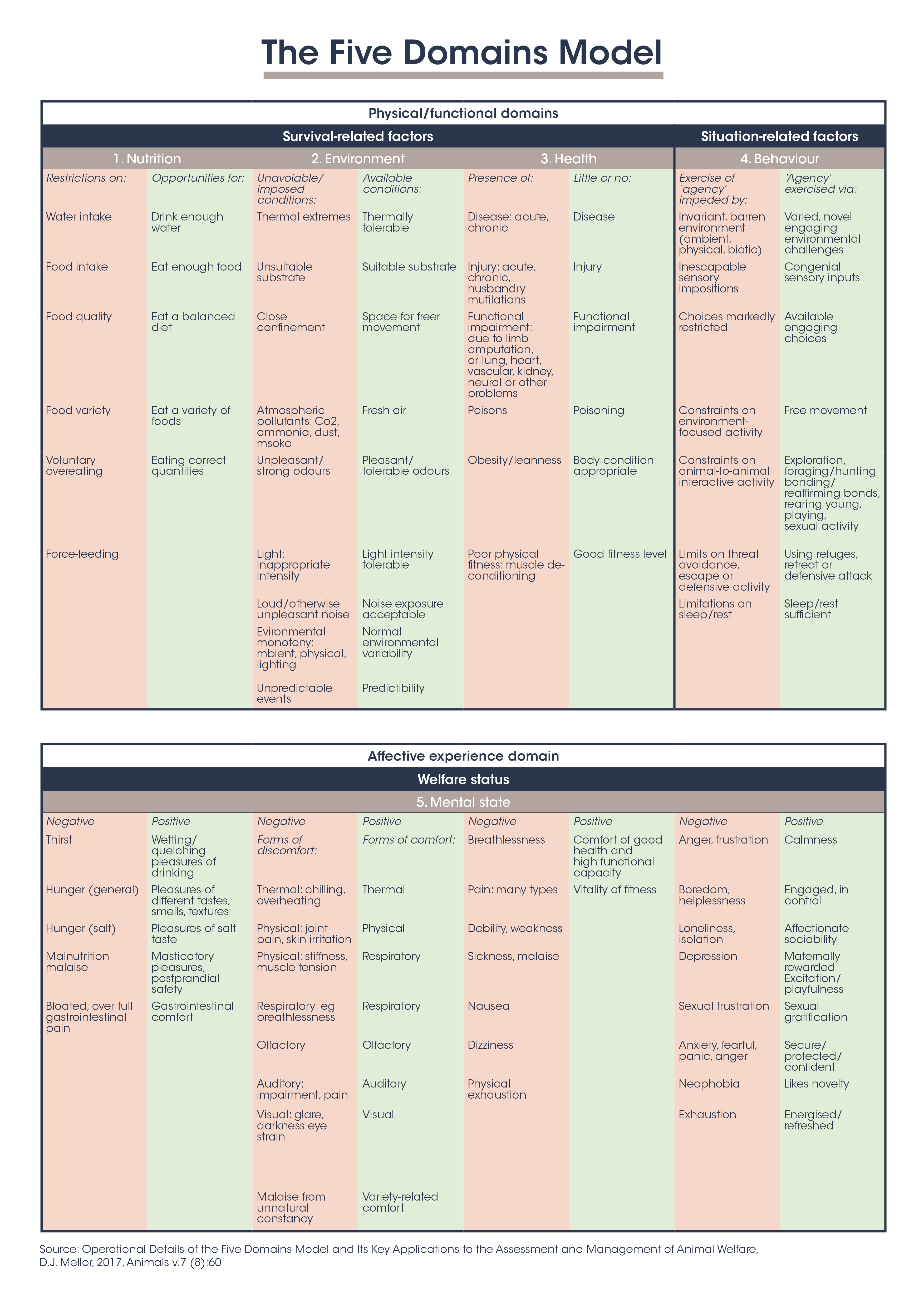How can we tell if an animal is truly well and has quality of life? The five domains model of animal welfare is designed to help scientists, veterinarians, animal caregivers in zoos and others evaluate and monitor the welfare of animals. But the model is also useful for us in our daily lives as we make decisions that affect the non-human animal kingdom. It can assist with considering whether to partake in animal-based activities as part of travel or other entertainment like in zoos. It is also a good lens through which to evaluate the well-being of our pets and the farm animals we rely on for food.
A bit of history about the subject. In 1979, the Farm Animal Welfare Council in the United Kingdom developed what was known as the five freedoms of animal welfare. The council (which is now a committee) is an independent advisory body to the UK government. As the name suggests, its focus is on farmed animals but the five freedoms of animal welfare it codified could be applied to other animals. Those five freedoms were as follows:
- Freedom from hunger or thirstby ready access to fresh water and a diet to maintain full health and vigour
- Freedom from discomfortby providing an appropriate environment including shelter and a comfortable resting area
- Freedom from pain, injury or diseaseby prevention or rapid diagnosis and treatment
- Freedom to express (most) normal behaviourby providing sufficient space, proper facilities and company of the animal’s own kind
- Freedom from fear and distressby ensuring conditions and treatment which avoid mental suffering
The five freedoms were adopted all over the world by veterinarians, societies for the prevention of cruelty to animals, and others and they were an excellent tool in improving the wellbeing of animals in an era when very little attention was paid to the subject. But, over time and as the world learned more about animal physiology and cognition, it became apparent that the freedoms should be expanded beyond just preventing negative experiences. Quality of life is measured not only by the absence of negative states but also the presence of positive states. That is as true for non-human animals as it is for us.
In 1994, the five domains of animal welfare emerged as a more expansive model with greater attention to factors related to quality of life. This revised model was created by Professor David Mellor and Dr. Cam Reid from Massey University in New Zealand. Since 1994, it has been revised multiple times to reflect new developments in animal welfare science and to include human-animal interactions in the assessment.
The five domains are:
1) Nutrition – this considers the quality and quantity of food and water an animal is being given. What are they being fed? How often? Is there variety in the diet? Are they being overfed? Do they have consistent access to fresh water? Where the five freedoms primarily focussed on sufficient water and food, this domain goes further considering nutritional needs for good physiological health but that positively affects quality of life. For illustration, if we think about cows in a factory farming setting, they are fed whatever it takes to make them as large as possible as fast as possible. Grain is the principal diet food for cows in factory farming even though their traditional diet is grass but all kinds of other things are sometimes added. And you might remember hearing about cows being fed Skittles candies in the United States. So, while these animals are not being starved, they are still experiencing a nutrition deficit. Another illustration of the importance of proper nutrition is with pet food. Many of us will have had the experience of seeing our dog’s or cat’s coat become thin and dull when eating certain brands of food and the situation improve quickly when switching to a different brand. All to say, nutrition matters. It matters for us and it matters for animals.
2) Environment – The second domain refers to the physical environment. Where the freedom from discomfort factor focussed on whether animals were provided appropriate shelter including space to rest, environment in the five domains model includes factors such as the extent to which the environment approximates the animal’s natural environment, how much autonomy the animal has to choose certain conditions like shade or being in the sun and the timing of their movement. This is a major issue in factory farming settings where chickens, pigs and cows are often overcrowded or crated in ways that prevent them from moving around or lying down. Environment in the five domains model looks beyond just appropriate shelter and space to rest to other important considerations that contribute to quality of life such as sights, sounds, comfort, variety, room for play, and when to engage in these activities.
3) Health – Freedom from pain, injury or disease is extended by the five domains model to health more generally. In addition to ensuring animals receive proper veterinary care for illness or injury, good health also involves factors such as proper exercise, sufficient sleep and disease prevention. Overall health is significantly impacted by the other domains. If an animal is not given a proper environment that allows the right musculoskeletal movement, physical health is impaired. If it is not provided with sufficient food and water, it will experience fatigue and lethargy, just as we humans do. The domain of health encourages scientists, veterinarians, zoo keepers, pet owners and policy makers to assess animal health more holistically.
4) Behaviour – this fourth domain encompasses how animals interact with their environment, with other animals and with humans. The freedom to express natural behaviours focussed on whether animals were able to engage in behaviour typical of their species. The behaviour domain provides an opportunity to assess behaviour and freedom of behaviour more thoroughly. It includes engaging in play, being free from threats, whether an animal is able to bond with other animals and the autonomy an animal has for exploration and movement. This domain, involves a continuum of behaviour where one end of the spectrum would reflect an animal having unimpeded agency over how it interacts with the environment and other animals and the other end of the continuum would involve constraint in space, sensory stimulus, access to other animals of the same kind and being subjected to punishment (physical or verbal) for its actions. Most circumstances lie somewhere between those poles. But being aware of the positive and negative interactions with environment, other animals and with humans is an important component to understanding animal welfare.
5) Mental state – The last domain is a comprehensive concept that recognizes the effects of the other four domains. Whereas the five freedoms model focussed on negative mental conditions such as fear and distress, mental state reflects the totality of conditions and experiences and how they impact an animal’s mental and emotional state. Animal scientists have been able to document grief, pleasure, joy, sadness, depression, restlessness, boredom, loneliness and other mental states in many species. Mental state affects quality of life for non-human animals as it does for us.
One can see the power of the five domains model for assessing animal welfare in diverse contexts. Those who work closely with animals like vets, animal scientists and zookeepers are able to apply it in a variety of ways. But it also has uses for us as pet owners, consumers and animal products and visitors to establishments like zoos and aquariums. Simply posing questions related to the five domains leads us to think about the welfare of animals in a way we wouldn’t do otherwise. And to make decisions accordingly.
Links:
Mellor D.J., Reid C.S.W. Concepts of animal well-being and predicting the impact of procedures on experimental animals. In: Baker R.M., Jenkin G., Mellor D.J., editors. Improving the Well-being of Animals in the Research Environment. Australian and New Zealand Council for the Care of Animals in Research and Teaching; Glen Osmond, Australia: 1994. https://org.uib.no/dyreavd/harm-benefit/Concepts%20of%20animal%20well-be….
Mellor DJ, Beausoleil NJ, Littlewood KE, McLean AN, McGreevy PD, Jones B, Wilkins C. The 2020 Five Domains Model: Including Human-Animal Interactions in Assessments of Animal Welfare. Animals (Basel). 2020 Oct 14;10(10):1870. doi: 10.3390/ani10101870. PMID: 33066335; PMCID: PMC7602120. https://pubmed.ncbi.nlm.nih.gov/33066335/
Graphic of factors within the five domains model: https://www.gwic.nsw.gov.au/__data/assets/image/0003/891039/5-Domains-Model.png



0 Comments